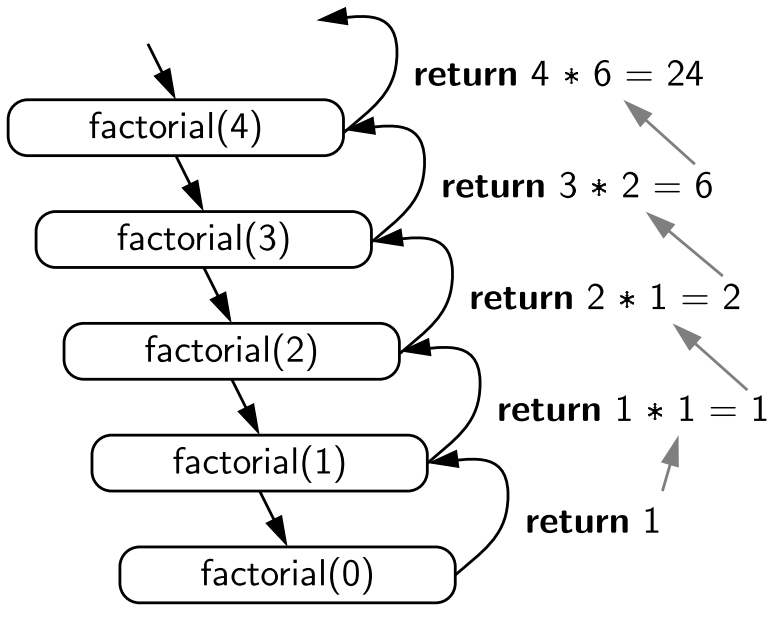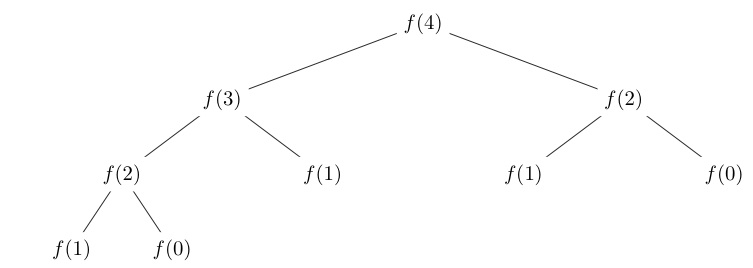Constructing a Recursive Solution
Overview
Teaching: 20 min
Exercises: 0 minQuestions
How does a recursive solution gets constructed and executed?
Objectives
Understand the mechanics of constructing a recursive solution, the way it is handled by the computer, in partiular the memory overhead.
We have seen a number of examples that employed recursion. It is time to dive deeper. Let us remind ourself of what recursion is:
-
Algorithmically: a way to design solutions to problems by divide-and-conquer.
-
Semantically: a programming technique where a function calls itself.
Divide and Conquer
Divide and conquer is an algorithm design paradigm based on multi-branched recursion. It works by recursively breaking down (reducing) a problem into (two or more) sub-problems of the same (or related type), until these become simple enough to be solved directly. The solutions to the sub-problems are then combined to give a solution to the original problem.
We can distill the idea of recursion into two simple rules:
- Each recursive call should be on a smaller instance of the same problem, that is, a smaller subproblem.
- The recursive calls must eventually reach a base case, which is solved without further recursion.
A good way to remember these rules is to think about Matryoshka doll (Russian nested dolls).

You can see that each doll encloses all a smaller dolls (analogous to the recursive case), until the smallest doll that does not enclose any others (like the base case).
Pitfall
If you forget to include a base case, or your recursive cases fail to eventually reach a base case, then infinite recursion happens. Infinite recursion is a special case of an infinite loop when a recursive function fails to stop recursing.
Recursion Trace
The execution of a recursive function is usually illustrated using a recursion trace.
Below is an example recursive trace for factorial(4):

- Each new recursive function call is indicated by a downward arrow to a new invocation.
- When the function returns, an arrow showing this return is drawn and the return value may be indicated alongside this arrow.
The recursion trace outlines the python’s execution of the recursion.
Activation Record
In Python, each time a function (recursive or otherwise) is called, a structure known as an activation record or frame is created to store information about the progress of that invocation of the function.
This activation record includes mechanism for storing the function call parameters and local variables among other things.
Call Stack
Computers use a structure called a stack to store information about activation records. A stack is a last-in/first-out memory structure: the last item placed is the first that can be removed.
When the execution of a function leads to a nested function call, the execution of the former call is suspended and its activation record stores the place in the source code at which the flow of control should continue upon return of the nested call.
This process is used both in the standard case of one function calling a different function, or in the recursive case in which a function invokes itself.
To see how this works, walk through the steps of computing factorial(4)
If the embedded program is not loaded here, click on this link to open it in a new tab.
StackOverflowError
Because each recursive call causes an activation record to be placed on the stack, infinite recursion can force the stack to grow beyond its limits to accommodate all the activation frames required. The result is a stack overflow. A stack overflow causes abnormal termination of the program.
In Python, the following error is
StackOverflowError
RecursionError: maximum recursion depth exceeded
Tail Recursion
A tail recursive function is one where every recursive call is the last thing done by the function before returning. In other words, there is nothing to do after the function returns except return its value.
For example, the
gcdfunction is tail-recursive. In contrast, thefactorialfunction is not tail-recursive.Some programming languages treats tail-recursive calls as jumps rather than function calls and are able to execute using constant space. In that case, the program is essentially iterative, equivalent to using imperative language control structures like the “for” and “while” loops.
Python does not optimize tail recursive function.
Recursion Tree
A recursion tree is useful for visualizing what happens when a recurrence is iterated. It diagrams the tree of recursive calls (and the amount of work done at each call).
Recursion tree is specially useful when the function makes more than one recursive calls.
For instance, the fib function which implements the Fibonacci sequence, makes two recursive calls
upon each invocation of the function. Here is the recursion tree for fib(4).

If you pay close attention to the figure, you will recognize a problem with the
fib function: some function calls are repeated multiple times.
It means some computations are done multiple times. This gets worse as input $n$ grows.
This example illustrates that recursive methods can take more time and consumes more memory than iteration, and thus lead to inefficient solutions.
Interesting and useful resources
Key Points
If a problem can be reduced to smaller instances of the same problem, then a recursive solution is a natural way to solve it.
When writing a recursive function definition, always confirm that the function will not produce infinite recursion.
Recursion bears substantial overhead. Each time the program calls a method, the system creates an activation frame and places it on the stack. This can consume considerable memory and requires extra time to manage the memory.